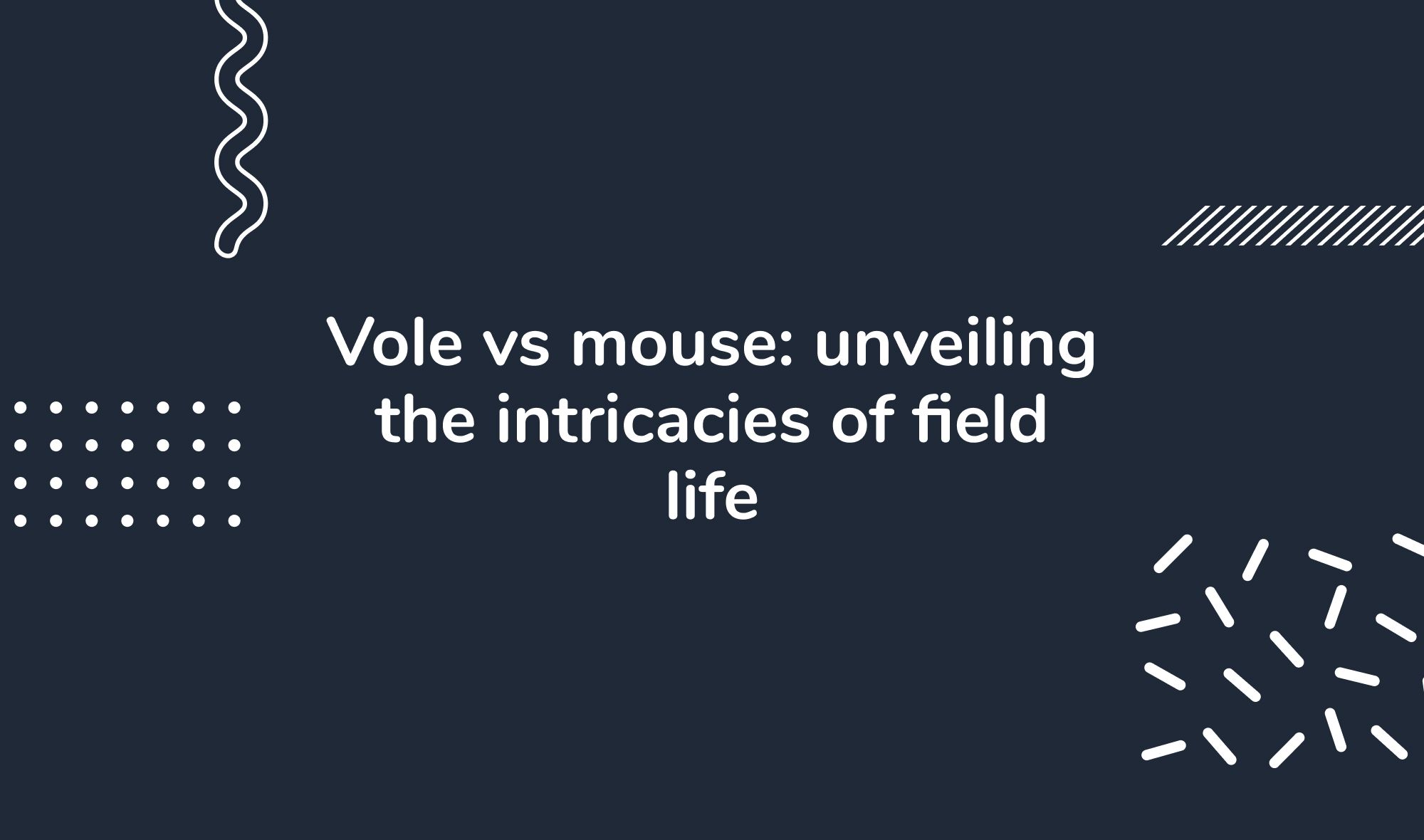Key Takeaways
- Voles and mice have distinctive physical traits and behaviors.
- Field mice and meadow voles are specific species with unique characteristics.
- Both voles and mice play crucial roles in their ecosystems, though their interaction with humans varies.
- Conservation status varies among species, and both face certain threats primarily from human activities.

In the world of small mammals, a riveting drama unfolds daily, mostly unnoticed by human eyes. In gardens, fields, and forests, the vole and the mouse, two captivating characters, live out their lives in a continual dance of survival.
Their tales are spun on a tiny scale, yet hold grand implications for the ecosystems they inhabit. "Vole vs mouse," "mouse vs vole,"—it's easy to confuse these petite creatures, yet each plays a distinct role in the intricate web of life.
Understanding the nuances that set apart the field mouse from the meadow vole, and vice versa, can not only quench our natural curiosity but also empower us to be more responsible stewards of our shared environment.
Come, let's journey together into this hidden world, to explore the fascinating lives of these often misunderstood creatures.
Join our newsletter
Stay on top of the latest in landscaping and lawn care with one valuable tip right in your inbox every Saturday morning.
Basic distinctions
Physical characteristics of a vole
Diving into the details, let's first explore the physical traits that define a vole. Voles, often referred to as meadow mice or field mice, are small mammals with compact, stocky bodies. They have a rounded head, small ears that are often hidden by their thick fur, and short tails. They typically sport a coat of brown or gray fur, a perfect camouflage in their preferred habitats.
Physical characteristics of a mouse
In contrast, mice present a slightly different physical composition. Generally smaller than voles, mice possess slender bodies and are characterized by their pointed snouts, large, round ears, and long, hairless tails. Their fur varies in color from white and gray to different shades of brown.
Comparison of a vole and a mouse in terms of appearance
In the vole vs mouse debate, appearance serves as the primary differentiator. The robust body and short tail of a vole is a stark contrast to the slender frame and long tail of a mouse. While their fur colors can be similar, adding to the confusion, it is their body structure and tail length that clearly distinguishes one from the other. So, if you ever find yourself questioning whether you have a vole or a mouse in your garden, take a closer look at these attributes.
Species spotlight: Field mouse and meadow vole

Description and traits of a field mouse
Venturing further into the world of these tiny creatures, let's highlight a specific species of mouse - the field mouse. Field mice encompass several species, but generally, they are noted for their small size, brown or grey fur, and large eyes. They are incredibly adaptable creatures and can be found in a variety of habitats including forests, grasslands, and often near human residences. Primarily nocturnal, field mice eat a varied diet, ranging from grains and seeds to fruits and insects.
Description and traits of a meadow vole
Conversely, the meadow vole, a common species of vole, demonstrates a few differing characteristics. Meadow voles are known for their stout bodies, short tails, and small hidden ears. They are usually active during the day, making them diurnal creatures, contrary to the nocturnal field mice. Meadow voles primarily reside in grasslands, meadows, or anywhere with dense ground cover. Their diet primarily consists of plant matter, which they forage for above ground or in shallow burrow systems.
Comparison: Field mouse vs meadow vole
When comparing a field mouse vs a meadow vole, their lifestyle differences become clear. A field mouse, primarily nocturnal, is more likely to be found in a broader range of habitats, including closer to human residences, while the meadow vole, a creature of the day, prefers the seclusion of dense grassy landscapes. Their diets differ as well, with field mice being more of an opportunist in their food choices, while meadow voles adhere to a strictly plant-based diet. These distinctions, among others, highlight the fascinating diversity within the lives of these tiny mammals.
Behavioral traits

Common behaviors of voles
Starting with voles, these industrious creatures display a suite of intriguing behaviors. Voles are primarily active during the day, with their lifestyle revolving around searching for food and maintaining their burrows. They are exceptional diggers, creating complex networks of tunnels with multiple entrances, which they navigate with ease. These burrow systems serve as protection against predators and the elements, and are also used for storing food. Additionally, voles tend to be quite social, living in small colonies with a defined hierarchical structure.
Common behaviors of mice
Mice, in contrast, are mainly nocturnal, active during the night when the risk of predation is lower. They are also proficient diggers, creating burrows for nesting and protection. However, their social structures differ somewhat from voles. While some species of mice do live in groups, others can be solitary, depending on the availability of food and mates. Their diet is diverse, and they are known for their extraordinary ability to adapt to different environments.
Join our newsletter
Stay ahead of the curve in all things outdoor.
Get the inside scoop on the latest landscaping, lawn care, and fencing trends with 1 actionable tip every Saturday morning.
Differences and similarities in behaviors between voles and mice
When comparing the behavioral traits of voles and mice, several key differences emerge. Their active periods are different, with voles being diurnal and mice being nocturnal. The social structures of voles and mice can vary as well, with voles typically being more sociable than mice.
However, they share similarities too. Both are skilled burrowers, creating intricate tunnel systems for protection, nesting, and food storage. Moreover, both voles and mice are mainly herbivorous, although mice can display more dietary flexibility. Understanding these behaviors enriches our perspective in the "vole vs mouse" exploration, illustrating that while these two creatures may look similar, their behaviors and lifestyles are uniquely their own.
Ecological role and habitat

Roles voles play in the ecosystem
Voles, despite their small size, play a significant role in their ecosystems. They help to maintain the health of grasslands and forests by aerating soil through their burrowing activities, enhancing soil fertility and promoting plant growth. Additionally, voles serve as an important food source for many predators, including owls, foxes, and snakes. Their existence helps to control the population of these predators, establishing a balance within their ecosystem.
Roles mice play in the ecosystem
Mice, too, contribute significantly to their environments. Similar to voles, their burrowing activities aerate the soil, assisting in nutrient cycling. Mice also aid in seed dispersal, as they often transport and store seeds in different locations. Moreover, they serve as a crucial food source for various predators, contributing to the regulation of predator populations.
Comparison of their roles: Vole vs mouse
Comparing the roles of voles and mice in the ecosystem reveals how intertwined they are within their habitats. Both contribute to soil aeration through their burrowing, promoting soil health. They also serve as a food source for a variety of predators, aiding in the balance of their respective ecosystems. Their roles, while similar, are integral to the health and diversity of their habitats.
The habitats of voles and mice
In terms of habitat, voles are typically found in meadows, grasslands, and woodland areas where dense undergrowth provides them with shelter and a plentiful food source.
Mice, on the other hand, display a broader habitat range. They are incredibly adaptable and can be found in forests, grasslands, and agricultural fields, often venturing into human residences.
Diet and lifespan

What do voles eat?
When it comes to their diet, voles are predominantly herbivorous. They feed on a variety of plant matter such as grasses, herbaceous plants, bulbs, and tubers. In some instances, they also consume bark, especially during the winter months when other food sources are scarce. Voles have also been observed to eat insects and animal remains, although these make up a minimal part of their diet.
What do mice eat?
Mice, on the other hand, are omnivorous creatures and have a more varied diet. While they also consume a lot of plant matter, such as seeds, fruits, and stems, they supplement their diet with a variety of insects, larvae, and occasionally small invertebrates. Mice have also been known to eat their feces to get access to nutrients produced by bacteria in their guts.
Comparison of their diets: Mouse vs vole
In the mouse vs vole dietary comparison, the key difference lies in their flexibility of food choices. While both consume plant matter, mice display more dietary diversity and opportunism, feeding on invertebrates and occasionally even small animals. In contrast, voles maintain a predominantly plant-based diet, occasionally feeding on insects and animal remains.
Lifespan of voles
Voles typically have a short lifespan. In the wild, they tend to live for about 3-6 months on average, although some may live up to a year. This short lifespan is largely due to high predation rates and harsh environmental conditions.
Lifespan of mice
Contrary to voles, mice tend to live longer, with a lifespan that can stretch up to two years in the wild under favorable conditions. However, in environments with high predation or limited resources, their lifespan can be considerably shorter.
Comparison of their lifespans: Vole vs mouse
When comparing the lifespan of a vole vs a mouse, it becomes apparent that mice generally outlive voles, often living up to two years, while voles live about 3-6 months. This disparity can be attributed to several factors, including predation rates, disease susceptibility, and environmental conditions, amongst others.
Understanding the diet and lifespan of voles and mice allows us to better appreciate these creatures and their respective niches in nature's grand design. Their diet and lifespan reflect their adaptability and resilience, underscoring their pivotal roles in maintaining ecological balance.
Interaction with humans

How voles interact with humans (in homes, gardens, etc.)
Voles generally keep a low profile when it comes to interactions with humans. However, they can occasionally cause significant damage to gardens and agricultural fields. This is primarily due to their feeding habits; they feed on a variety of plant material, including the roots and stems of many garden plants. Additionally, their extensive burrow systems can undermine the structural integrity of gardens and lawns, leading to noticeable surface trails and potentially damaging planted areas.
How mice interact with humans
Mice interactions with humans are more common, often leading to a categorization of mice as pests. Mice have a tendency to inhabit human homes and buildings in search of food and shelter, especially during colder months. This cohabitation can lead to significant damage to property as they gnaw on various materials for nesting or to keep their teeth size in check. Furthermore, mice can pose a health risk as they can carry a variety of diseases that are transmissible to humans.
Comparison of their interactions: Vole vs mouse
Comparing the interactions of voles and mice with humans, mice undoubtedly have a greater impact. While voles can cause damage to gardens and fields, their interaction with humans remains largely outdoors. Mice, on the other hand, are more likely to venture into human dwellings, which can result in more direct conflict due to property damage and potential health risks. Understanding these interactions is not only essential for effective pest control but also allows us to better coexist with these creatures, acknowledging their roles in the ecosystem.
Conservation status and threats

The conservation status of voles
Voles, in general, are not considered endangered or threatened. The International Union for Conservation of Nature (IUCN) lists most species of voles as of "Least Concern," meaning they are currently not facing significant threats that could lead to their extinction. However, the status may vary with different species and geographical locations.
The conservation status of mice
Similar to voles, many species of mice are not under immediate threat, with their conservation status listed as "Least Concern" by the IUCN. However, there are exceptions, particularly for mice species that are endemic to certain regions or islands, and therefore have limited distribution. These species are more vulnerable to changes in their environment and may face higher risks of extinction.
Major threats voles face
Although generally not threatened, voles do face certain challenges. Habitat destruction due to human activities, such as agriculture and urbanization, is among the main threats to vole populations. Additionally, predation and harsh weather conditions can also impact their survival rate.
Major threats mice face
Mice, due to their adaptability and widespread distribution, face fewer threats. However, similar to voles, habitat destruction can pose a problem, especially for those species with a limited range. Predation and disease can also impact mice populations.
Comparison of their threats: Vole vs mouse
When comparing threats to voles and mice, both species face similar challenges. Habitat destruction, predation, and disease are common threats. However, due to their adaptability and wider distribution, mice generally face fewer threats compared to certain vole species with a more restricted range. Recognizing these threats is crucial for implementing effective conservation strategies and ensuring these creatures continue to play their role in our ecosystems.
Conclusion
The intricate tapestry of nature is woven together by countless species, each playing a crucial role. The vole and the mouse, though seemingly small and insignificant, contribute to this grand design in remarkable ways. Our exploration into the world of these two creatures, dissecting the complexities of the "vole vs mouse" dichotomy, has led us to understand their distinct physical traits, behaviors, ecological roles, and interactions with humans.
We've discovered that, despite their superficial similarities, voles and mice lead different lives and occupy distinct ecological niches. From their diets and lifespan to their habits and habitats, the differences are as striking as the similarities. While their interactions with humans may vary, both species significantly impact our lives, whether as challenging pests or as crucial contributors to the health of our ecosystems.
The threats they face, primarily due to human activities, remind us of our responsibility in maintaining the intricate balance of nature. As we continue to share our world with these fascinating creatures, understanding their lives, appreciating their contributions, and acknowledging their challenges can help us coexist in a more balanced and respectful manner.
In the grand comparison of "vole vs mouse," perhaps the most important takeaway is the realization of their vital roles in the ecosystem, driving home the necessity for their preservation. We look forward to our next journey of discovery, venturing into the lesser-known corners of our natural world.
Join our newsletter
Stay ahead of the curve in all things outdoor.
Get the inside scoop on the latest landscaping, lawn care, and fencing trends with 1 actionable tip every Saturday morning.